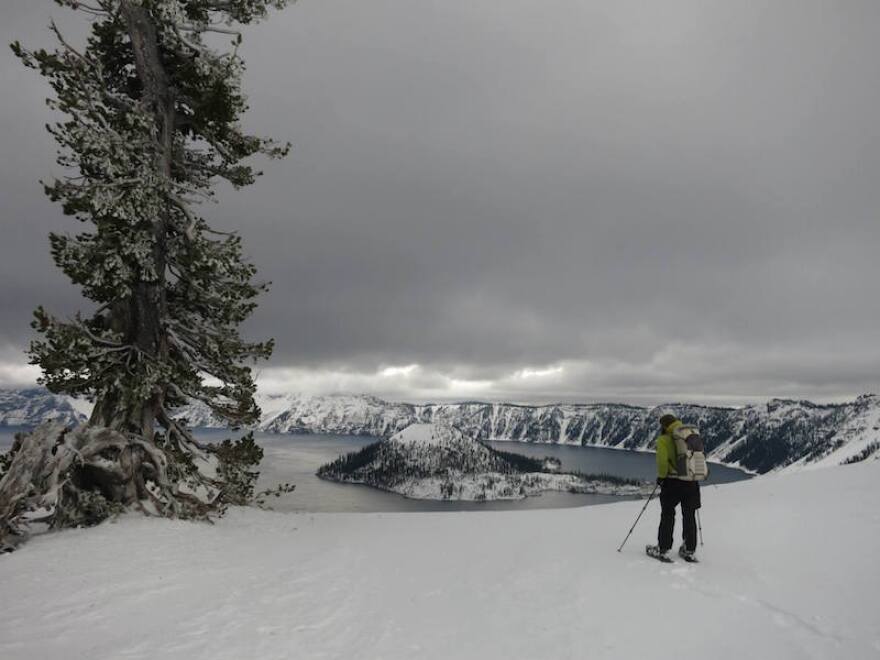A pair of experienced long distance hikers are more than halfway through a full traverse of the Pacific Crest Trail - in the dead of winter.
If Californians Shawn Forry and Justin Lichter reach the Mexican border this spring, they'll be the first on record to hike the length of the crest trail when it's mostly covered in snow.
The two men set off southbound from the Canadian border down the spine of the Cascades on October 21. They got to the Columbia River in 20 days on boots and snowshoes. Then Oregon took a month to traverse. Forry distinctly remembers being buffeted by 60 mph wind gusts near Mount Hood, right before the trip's first big dump of two to three feet of snow.
They're now skirting Lake Tahoe on backcountry skis.
According to the Pacific Crest Trail Association, no one is known to have completed a wintertime thru-hike of the 2,660 mile trail before.
’It’s just one foot in front of the other’

Forry said he's well aware the winter trek strikes some observers as crazy. "When it comes down to it, it's just one foot in front of the other, managing the risk and dealing with the weather and whatever comes your way," he said.
So far, Lichter said this winter's low snowpack has lessened the avalanche peril. "It hasn't felt that dangerous," he said. "Now going into the High Sierra things will change a little bit because there is snowpack."
Lichter said at the current pace, the adventurers expect to arrive at the Mexican border in late March or around the beginning of April.
On his trail blog, Lichter repeatedly praised the advantages of winter hiking including, "no forest fires or fire reroutes... bountiful, clear, cold water, a mosquito-less Oregon and a beautiful coating of snow on every tree."
Both hikers said they embarked on this trek to challenge and broaden their already considerable outdoor skills. Lichter added that he was curious to see familiar places in a different time of year and light.
A popularity boom on the PCT

The PCTA expects the crest trail to undergo a surge of popularity this year in the wake of the movie "Wild" starring Reese Witherspoon. The adaptation of Portland writer Cheryl Strayed's memoir describes how a solo hiker re-centered herself during a long trek on the trail.
Forry sees pros and cons from the added attention to the scenic trail.
"It's always great when more and more people are getting outside and experiencing wilderness," he said. "The downside the PCT will face in the coming years is... you'll see more and more impact on the wilderness."
But for now Forry and Lichter have the entire trail to themselves.
"We haven't seen anyone on the trail - if you can call it that - for months," Lichter said .
Forty-pound packs and 15-mile days
Forry, 33, is an Outward Bound instructor now living near the edge of Yosemite National Park. Lichter, 34, hails from Truckee, California, where he works as a ski patroller when not out on a trail.

The two averaged a brisk 25 miles per day over the initial Pacific Crest Trail segment in Washington, which was dominated by "lots and lots of rain."
There were "only two dry days in nearly three weeks. It was great to finally get some views and see all of the peaks around the area," Lichter wrote on his trail blog.
It started to snow in earnest as the hikers crossed Oregon. Their pace slowed to about 15 miles per day. When the trail crosses a road, the pair may grant themselves a rest day or resupply foray. They have hitched rides into nearby towns to sleep in a home or motel and dry out.
Forry and Lichter have to carry more gear than the usual mild-season distance hiker, but still are using "ultralight" techniques to keep their backpacks under 40 pounds. Their survival gear includes avalanche probes and a satellite locator beacon.
For navigation, "we rely almost entirely on map and compass," said Forry. "The trail provides you a lot of subtle clues to its location. There is usually a faint depression in the snow from the well-trodden tread. There are occasionally old ax blazes in the trees or similar trail markers as well as signs of trail maintenance, like cut logs and limbs."
Forry and Lichter also benefit from familiarity with the terrain. The two first met on the Pacific Crest Trail in 2004 near Washington's Snoqualmie Pass. "Both of us have hiked large sections of the trail since then, particularly here in the Sierra," Forry said during a rest and resupply stop in Truckee.
See more photos of Forry and Lichter's trek on Forry's Facebook page










